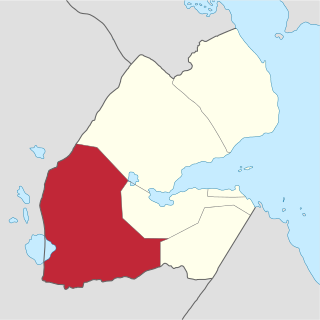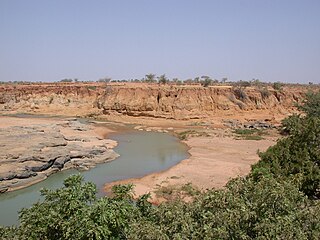| Asa Koma | |
|---|---|
 Pottery found in Asa Koma | |
| Location | Asa Koma, Djibouti |
| Access | Public |
Asa Koma ("Red Hill") is an archaeological site in Djibouti.
| Asa Koma | |
|---|---|
 Pottery found in Asa Koma | |
| Location | Asa Koma, Djibouti |
| Access | Public |
Asa Koma ("Red Hill") is an archaeological site in Djibouti.
Asa Koma is an inland lake area on the Gobaad Plain. The site of Wakrita is a small Neolithic establishment located on a wadi in the tectonic depression of Gobaad in Djibouti in the Horn of Africa. The 2005 excavations yielded abundant ceramics that enabled us to define one Neolithic cultural facies of this region, which was also identified at the nearby site of Asa Koma. The faunal remains confirm the importance of fishing in Neolithic settlements close to Lake Abbe, but also the importance of bovine husbandry and, for the first time in this area, evidence for caprine herding practices. Radiocarbon dating places this occupation at the beginning of the 2nd millennium BC, similar in range to Asa Koma. These two sites represent the oldest evidence of herding in the region, and they provide a better understanding of the development of Neolithic societies in this region. Radiocarbon of the pottery dated the 2nd millennium BC. The ware is characterized by punctate and incision geometric designs, which bear a similarity to the Sabir culture phase 1 ceramics from Ma'layba in Southern Arabia. [1] Additionally, ceramics like some of the pottery from Sihi on the Saudi coast and Subr on the Yemeni littoral have been found here. [2]
Long-horned humpless cattle bones have also been discovered at Asa Koma, suggesting that domesticated cattle was present by around 3,500 years ago. [3]
The Copper Age, also called the Chalcolithic or (A)eneolithic, is an archaeological period characterized by regular human manipulation of copper, but prior to the discovery of bronze alloys. Modern researchers consider the period as a subset of the broader Neolithic, but earlier scholars defined it as a transitional period between the Neolithic and the Bronze Age.
Djibouti is a country in the Horn of Africa. It is bordered by Somalia to the southeast, Eritrea and the Red Sea to the north and northwest, Ethiopia to the west and south, and the Gulf of Aden to the east.

The Mesolithic or Middle Stone Age is the Old World archaeological period between the Upper Paleolithic and the Neolithic. The term Epipaleolithic is often used synonymously, especially for outside northern Europe, and for the corresponding period in the Levant and Caucasus. The Mesolithic has different time spans in different parts of Eurasia. It refers to the final period of hunter-gatherer cultures in Europe and Western Asia, between the end of the Last Glacial Maximum and the Neolithic Revolution. In Europe it spans roughly 15,000 to 5,000 BP; in Southwest Asia roughly 20,000 to 10,000 BP. The term is less used of areas farther east, and not at all beyond Eurasia and North Africa.

The Neolithic period, or New Stone Age, is an Old World archaeological period and the final division of the Stone Age. It saw the Neolithic Revolution, a wide-ranging set of developments that appear to have arisen independently in several parts of the world. This "Neolithic package" included the introduction of farming, domestication of animals, and change from a hunter-gatherer lifestyle to one of settlement.

The Vinča culture, also known as Turdaș culture, Turdaș–Vinča culture or Vinča-Turdaș culture, is a Neolithic archaeological culture of Southeast Europe, dated to the period 5700–4500 BC or 5300–4700/4500 BC. Named for its type site, Vinča-Belo Brdo, a large tell settlement discovered by Serbian archaeologist Miloje Vasić in 1908, it represents the material remains of a prehistoric society mainly distinguished by its settlement pattern and ritual behaviour.

The Starčevo culture is an archaeological culture of Southeastern Europe, dating to the Neolithic period between c. 6200 and 4500 BCE. It originates in the spread of the Neolithic package of peoples and technological innovations including farming and ceramics from Anatolia to the area of Sesklo. The Starčevo culture marks its spread to the inland Balkan peninsula as the Cardial ware culture did along the Adriatic coastline. It forms part of the wider Starčevo–Körös–Criş culture which gave rise to the central European Linear Pottery culture c. 700 years after the initial spread of Neolithic farmers towards the northern Balkans.

The Dikhil Region is a region in southern Djibouti. It is bordered by the Regions of Tadjoura to the north, Arta to the northeast, Ali Sabieh to the east. To the west and south, it has a long line with the Djibouti-Ethiopia border adjacent to the Ethiopia Regions of Afar Region and Somali Region. Dikhil Region is the largest Region in Djibouti by area, with a mainland area of 7,200 square kilometres, it is about the same size as Sikkim. The Dikhil Region's capital is the town of Dikhil.

The Longshanculture, also sometimes referred to as the Black Pottery Culture, was a late Neolithic culture in the middle and lower Yellow River valley areas of northern China from about 3000 to 1900 BC. The first archaeological find of this culture took place at the Chengziya Archaeological Site in 1928, with the first excavations in 1930 and 1931. The culture is named after the nearby modern town of Longshan in Zhangqiu, Shandong. The culture was noted for its highly polished black pottery. The population expanded dramatically during the 3rd millennium BC, with many settlements having rammed earth walls. It decreased in most areas around 2000 BC until the central area evolved into the Bronze Age Erlitou culture. The Longshan culture has been linked to the early Sinitic . According to the area and cultural type, the Longshan culture can be divided into two types: Shandong Longshan and Henan Longshan. Among them, Shandong Longshan Cultural Site includes Chengziya Site; Henan Longshan Cultural Site includes Dengfeng Wangchenggang Site in Wangwan, Taosi Site and Mengzhuang Site in Hougang.
Asbestos-ceramic is a type of pottery manufactured with asbestos and clay in Finland, Karelia and more widely in Fennoscandia from around 5000 BC. Some remnants of this style of pottery lasted until as late as 200 AD. These ceramics are able to retain heat longer than other pottery.

Nabta Playa was once a large internally drained basin in the Nubian Desert, located approximately 800 kilometers south of modern-day Cairo or about 100 kilometers west of Abu Simbel in southern Egypt, 22.51° north, 30.73° east. Today the region is characterized by numerous archaeological sites. The Nabta Playa archaeological site, one of the earliest of the Egyptian Neolithic Period, is dated to circa 7500 BC.

Shahr-e Sukhteh, c. 3200–2350 BC, also spelled as Shahr-e Sūkhté and Shahr-i Sōkhta, is an archaeological site of a sizable Bronze Age urban settlement, associated with the Helmand culture. It is located in Sistan and Baluchistan Province, the southeastern part of Iran, on the bank of the Helmand River, near the Zahedan-Zabol road. It was placed on the UNESCO World Heritage List in June 2014.
As Ela, As Eyla, It is located around 160 kilometres southwest of the capital, Djibouti City and 5 km north of the border with Ethiopia. It is located along the National Highway 6. Tourist richness which the crater formed Lake Abbe, As' Eyla Province is located within the boundaries.

The Pre-Pottery Neolithic (PPN) represents the early Neolithic in the Levantine and upper Mesopotamian region of the Fertile Crescent, dating to c. 12,000 – c. 8,500 years ago,. It succeeds the Natufian culture of the Epipalaeolithic Near East, as the domestication of plants and animals was in its formative stages, having possibly been induced by the Younger Dryas.

Djibouti, officially the Republic of Djibouti, is a country in the Horn of Africa, bordered by Somalia to the south, Ethiopia to the southwest, Eritrea in the north, and the Red Sea and the Gulf of Aden to the east. The country has an area of 23,200 km2 (8,958 sq mi).

Sarazm is an ancient town and also a jamoat in north-western Tajikistan. It dates back to the 4th millennium BC and is today a UNESCO World Heritage Site. The jamoat is part of the city of Panjakent in Sughd Region, and has a total population of 27,877 (2015). It consists of 21 villages, including Chimqal'a, Abdusamad, Bostondeh, Kamar, Kamar-Tash and Sohibnazar.

Ounjougou is the name of a lieu-dit found in the middle of an important complex of archaeological sites in the Upper Yamé Valley on the Bandiagara Plateau, in Dogon Country, Mali. The Ounjougou archaeological complex consists of over a hundred sites. The analysis of many layers rich in archaeological and botanical remains has enabled establishment of a major chronological, cultural and environmental sequence crucial to understand settlement patterns in the Inland Niger Delta and West Africa. Ounjougou has yielded the earliest pottery found in Africa, and is believed to be one of the earliest regions in which the independent development of pottery occurred.

The Pastoral Neolithic refers to a period in Africa's prehistory, specifically Tanzania and Kenya, marking the beginning of food production, livestock domestication, and pottery use in the region following the Later Stone Age. The exact dates of this time period remain inexact, but early Pastoral Neolithic sites support the beginning of herding by 5000 BP. In contrast to the Neolithic in other parts of the world, which saw the development of farming societies, the first form of African food production was nomadic pastoralism, or ways of life centered on the herding and management of livestock. The shift from hunting to food production relied on livestock that had been domesticated outside of East Africa, especially North Africa. This period marks the emergence of the forms of pastoralism that are still present. The reliance on livestock herding marks the deviation from hunting-gathering but precedes major agricultural development. The exact movement tendencies of Neolithic pastoralists are not completely understood.
To understand past cultures archaeologists analyze many artifacts. Pottery proves to be of most importance to the archaeological record. Pottery is durable and even allows its broken fragments to withstand time, which would otherwise decompose other artifacts. More importantly, the style of pottery often changes through time, and shifts in shape, size, or decoration can be used to resolve the age of the artifact and/or site. Furthermore, though pottery is common, different cultures had their own distinct styles that can be used to determine its similarities or differences with one another. Therefore, even fragments of pottery can reconstruct many facets of past cultures.

Sohr Damb, c. 3800–2300 BC, is an archaeological site, located near Nal, in central Balochistan, Pakistan that begins before the Indus Valley civilization featuring Togau, Kili Ghul Mohammad, and Kechi Beg pottery styles. It has also been known as 'Nal', and gave its name to the prehistoric Amri-Nal culture, which is attributed to the dual typesites of Amri and Nal.
The Tichitt Culture, or Tichitt Tradition, was created by Mande peoples. In 4000 BCE, the start of sophisticated social structure developed among herders amid the Pastoral Period of the Sahara. Saharan pastoral culture was intricate. By 1800 BCE, Saharan pastoral culture expanded throughout the Saharan and Sahelian regions. The initial stages of sophisticated social structure among Saharan herders served as the segue for the development of sophisticated hierarchies found in African settlements, such as Dhar Tichitt. After migrating from the Central Sahara, Mande peoples established their civilization in the Tichitt region of the Western Sahara. The Tichitt Tradition of eastern Mauritania dates from 2200 BCE to 200 BCE.